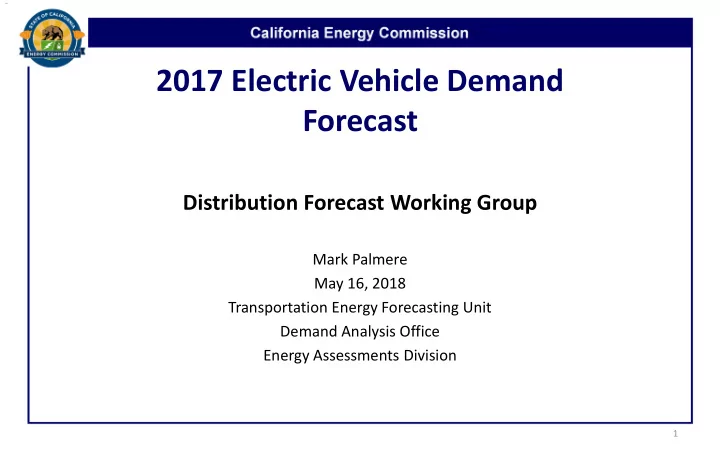

2017 Electric Vehicle Demand Forecast Distribution Forecast Working Group Mark Palmere May 16, 2018 Transportation Energy Forecasting Unit Demand Analysis Office Energy Assessments Division 1
Transportation Demand Cases Cases represent different levels of transportation electricity demand ▪ Transportation Demand Cases High Electricity Demand (High Case) • Inputs selected to represent high level of electricity demand Mid Electricity Demand (Mid Case) Low Electricity Demand (Low Case) • Inputs selected to represent low level of electricity demand ▪ Inputs – Income, population, fuel prices, vehicle attributes 2
Plug-in Electric Vehicle Scenarios PEV SCENARIOS INPUTS Low Mid High Aggressive Bookend PREFERENCES Consumers' PEV Increase with PEV market Increase with PEV market Increase with PEV market Increase with PEV market Constant at 2017 Level Preference growth growth growth growth INCENTIVES Federal Tax Credit Eliminated after 2019 Decreasing starting 2019 Decreasing starting 2019 Constant through 2030 Constant through 2030 State Rebate To 2019 To 2025 To 2025 To 2030 To 2030 To 2025 for PHEV / 2030 To 2025 for PHEV / 2030 HOV Lane Access To 2021 To 2025 To 2025 for BEV for BEV ATTRIBUTES Availability of PEVs PEV models available in 11 PEV models available in 11 PEV models available in 11 PEV models available in 13 PEV models available in all (in 2030) of 15 CEC LDV classes of 15 CEC LDV classes of 15 CEC LDV classes of 15 CEC LDV classes CEC LDV classes PEV prices based on PEV prices based on PEV prices based on PEV prices based on Vehicle / Battery Price PEV prices reach parity battery price declining to battery price declining to battery price declining to battery price declining to (by 2030) with gasoline vehicles ~$120/kWh ~$100/kWh ~$89/kWh ~$73/kWh Avg. Range (2030) ~230 miles ~230 miles ~270 miles ~270 miles ~270 miles Refuel Time (2030) 15 -21 min 15 -21 min 10-16 min 10-16 min Same as gasoline Time to Station (2030) 7-8 min Same as gasoline Same as gasoline Same as gasoline Same as gasoline by 2025 FORECAST RESULTS PEV STOCK in 2030 2.6 million 3.3 million 3.9 million 5.3 million 5.9 million Cost of State Rebate, $577 million $4.2 billion $4.6 billion $5.2 billion $5.4 billion 2018-2025 Cost of State Rebate - - - $7.1 billion $8.2 billion Extension, 2026-2030 3
Attribute Forecasts Battery Pack Cost Estimates Projected # of Light-Duty ZEV Models Mid Case Largest Component Cost in Electric Vehicles 4
BEV Range and Price ▪ Battery costs are falling… ▪ But average price of BEVs rose… “The average price of EVs rose again in 2016, but this reflects faster growth in more expensive models and does not take account of increases in driving range… reductions in battery costs are translating into longer ranges rather than lower vehicle prices ” - International Energy Agency ▪ TEFU is using a new metric to show relative decline in BEV prices. ▪ CEC Forecast of Avg. BEV Range: – 2015 forecast: Flat at ~115 miles – 2017 forecast: Rising to 240-280 miles Source: www.iea.org/newsroom/energysnapshots/average-ev-price-and-range.html 5
Transportation Models Key Inputs & Outputs 6
ZEV and PHEV Stock Continues to Grow Cumulative On-road BEVs, PHEVs, and FCEVs Millions 4.0 HIGH 3.5 State Rebate Discontinued after 3.0 2025 MID 2.5 Cumulative Stock LOW 2.0 1.5 ARB ZEV Mid-term Review Compliance 1.0 Estimates 0.5 0.0 2005 2010 2015 2020 2025 2030 Source: California Energy Commission, California Air Resources Board 7
Regional Distribution of EVs Forecasting Zones ▪ California Energy Commission has divided the state into 20 zones when forecasting at the regional level. ▪ Zone lines are drawn in order to distinguish utility coverage. ▪ Larger utilities (SCE, PG&E, LADWP) serve multiple zones.
Regional Distribution of EVs Calculating Zone-level Population ▪ Transportation energy demand models calculate statewide vehicle stock, by fuel, class, and vintage. ▪ To allocate stock at a regional level, we use data that are predictors of EV penetration rates. – These are household and per capita income data, which come from Moody’s and the Department of Finance. ▪ Regression equations are used to estimate PEV distribution by forecast zone. • BEV Stock = f (Households, Per Capita Income) • PHEV Stock = f (Households, Per Capita Income)
Regional Distribution of EVs Electricity Consumption Accounting For Travel Differences ▪ Calculate avg. annual VMT by county and year. (Source: ARB’s EMFAC) – Divide total VMT by forecast of total vehicles in each county. ▪ Calculate “VMT Ratio” for each forecast zone, where 𝑔𝑝𝑠𝑓𝑑𝑏𝑡𝑢 𝑝𝑔 𝑏𝑤. 𝑊𝑁𝑈 𝑔𝑨, 𝑢 𝑊𝑁𝑈 𝑠𝑏𝑢𝑗𝑝 𝑔𝑨, 𝑢 = 𝑔𝑝𝑠𝑓𝑑𝑏𝑡𝑢 𝑝𝑔 𝑏𝑤. 𝑡𝑢𝑏𝑢𝑓𝑥𝑗𝑒𝑓 𝑊𝑁𝑈 𝑢 ▪ Transportation energy demand models calculate state electricity consumption from all EVs. ▪ Convert to electricity consumption by forecast zone multiplying VMT and vehicle ratios by statewide electricity demand.
Regional Distribution of EVs Calculating Electricity Consumption ▪ Transportation energy demand models calculate state electricity consumption from all EVs. ▪ Convert to electricity consumption by forecast with the following equations: BEV 𝑓𝑚𝑓𝑑𝑢𝑠𝑗𝑑𝑗𝑢𝑧 𝑔𝑨, 𝐶𝐹𝑊, 𝑢 = 𝑓𝑚𝑓𝑑𝑢𝑠𝑗𝑑𝑗𝑢𝑧 𝐷𝐵, 𝐶𝐹𝑊, 𝑢 𝑦 𝐶𝐹𝑊 𝑠𝑏𝑢𝑗𝑝 𝑔𝑨, 𝑢 𝑦 𝑊𝑁𝑈 𝑠𝑏𝑢𝑗𝑝 𝑔𝑨, 𝑢 PHEV 𝑓𝑚𝑓𝑑𝑢𝑠𝑗𝑑𝑗𝑢𝑧 𝑔𝑨, 𝑄𝐼𝐹𝑊, 𝑢 = 𝑓𝑚𝑓𝑑𝑢𝑠𝑗𝑑𝑗𝑢𝑧 𝐷𝐵, 𝑄𝐼𝐹𝑊, 𝑢 𝑦 𝑄𝐼𝐹𝑊 𝑠𝑏𝑢𝑗𝑝 𝑔𝑨, 𝑢 𝑦 𝑊𝑁𝑈 𝑠𝑏𝑢𝑗𝑝 𝑔𝑨, 𝑢 𝑓𝑚𝑓𝑑𝑢𝑠𝑗𝑑𝑗𝑢𝑧 𝑔𝑨, 𝐹𝑊, 𝑢 = 𝑓𝑚𝑓𝑑𝑢𝑠𝑗𝑑𝑗𝑢𝑧 𝑔𝑨, 𝐶𝐹𝑊, 𝑢 + 𝑓𝑚𝑓𝑑𝑢𝑠𝑗𝑑𝑗𝑢𝑧 𝑔𝑨, 𝑄𝐼𝐹𝑊, 𝑢
Regional Distribution of EVs Results BEV and PHEV Population by Utility, Mid Case BEV and PHEV Electricity Consumption by Utility, Mid Case 4,000,000 16,000 3,500,000 14,000 3,000,000 12,000 Consumption (GWh) 2,500,000 10,000 Vehicle Count 2,000,000 8,000 1,500,000 6,000 1,000,000 4,000 500,000 2,000 - - 2017 2018 2019 2020 2021 2022 2023 2024 2025 2026 2027 2028 2029 2030 2017 2018 2019 2020 2021 2022 2023 2024 2025 2026 2027 2028 2029 2030 PG&E SCE SDG&E POUs PG&E SCE SDG&E POUs
Thank You For further questions, please contact: – Laura Zaninovich, Transportation Energy Forecasting Unit Supervisor • Laura.Zaninovich@energy.ca.gov – Aniss Bahreinian, Lead Transportation Forecaster • Aniss.Bahreinian@energy.ca.gov – Sudhakar Konala, ZEV Analysis • Sudhakar.Konala@energy.ca.gov – Mark Palmere, Light Duty Vehicles • Mark.Palmere@energy.ca.gov 13
Recommend
More recommend